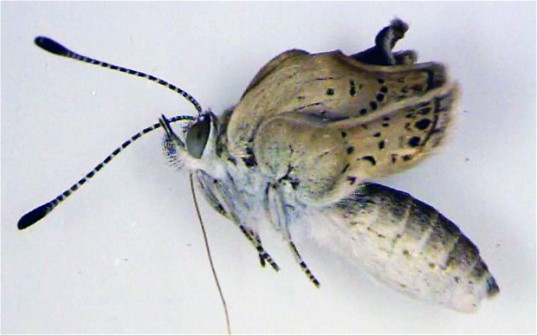 Researchers who collected and studied 100 pale grass blue butterflies from the Fukushima prefecture following last year’s nuclear meltdown have discovered serious mutations resulting from exposure to radiation. The butterflies, which were collected two months after the March, 2011 earthquake and tsunami caused the worst nuclear disaster since Chernobyl, had abnormalities in their legs, antennae and abdomens, as well as dents in their eyes. Some of them had broken or wrinkled wings and changes in wing size and markings.
Researchers who collected and studied 100 pale grass blue butterflies from the Fukushima prefecture following last year’s nuclear meltdown have discovered serious mutations resulting from exposure to radiation. The butterflies, which were collected two months after the March, 2011 earthquake and tsunami caused the worst nuclear disaster since Chernobyl, had abnormalities in their legs, antennae and abdomens, as well as dents in their eyes. Some of them had broken or wrinkled wings and changes in wing size and markings.
Hit the jump to learn more about the study published in Scientific Reports if you need more convincing that nuclear power in earthquake-prone areas of the Middle East are an especially bad idea.
CNN reports that 12% of the pale grass blue butterflies collected in May, 2011 showed abnormalities as a result of radiation exposure. After the butterflies mated, 18% of the offspring had mutations of some kind.
And when mated with butterflies that were nowhere near Fukushima throughout the nuclear disaster, the percentage of mutations rose to 34%.
“[This indicates] that the mutations were being passed on through genes to offspring at high rates even when one of the parent butterflies was healthy,” according to CNN.
Another 200 butterflies were collected from the Fukushima prefecture in September,2011 to get a sense of how those butterflies fared. It turns out that 28% of them had many of the mutations described above and 52% of their offspring had morphed in some way. Many died before reaching maturity.
“The study indicated that second-generation butterflies, the ones collected in September, likely saw higher numbers of mutations because they were exposed to the radiation either as larvae or earlier than adult butterflies first collected,” according to CNN.
Scientists claim that butterflies are especially sensitive to radiation so it’s crucial to sample other species to gain a concise understanding of how the Fukushima disaster has impacted the surrounding ecosystem. Joji Otaki, an associate professor at the University of the Ryukyus in Okinawa, told Japan Times that humans are more tolerant to radiation.
Which means we shouldn’t expect to see human babies born with wrinkled wings just yet. Still, do we really want to risk building nuclear power plants in Turkey, or Iran, both of which countries regularly experience devastating earthquakes?
:: CNN



